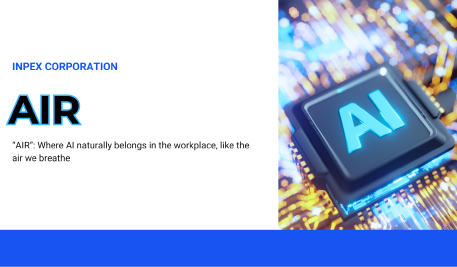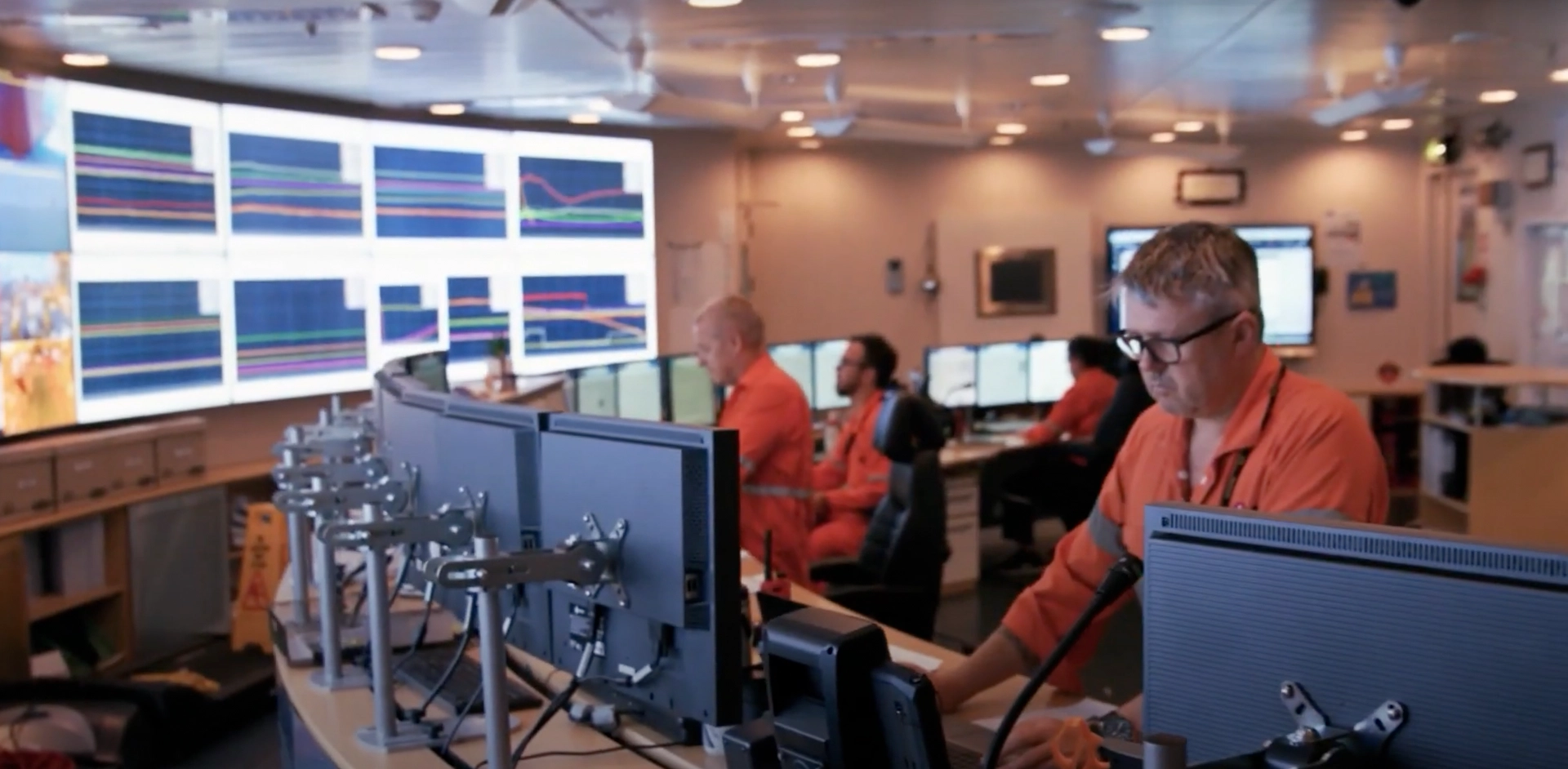The advancement of digital technologies brings great opportunities to pioneer new businesses and reduce costs through operational efficiencies. However, digitization also poses threats of cybersecurity risks and increasingly competitive markets. Investment an innovation is essential for adapting to these technological changes and for continuing growth. There are also important social and ethical considerations associated with the adoption of artificial intelligence (AI) and other advanced technologies. A comprehensive understanding of these factors, together with strategic responses, will lead to sustainable growth for companies in the age of digitalization.
At INPEX, we have formulated a DX Vision and DX Strategy to help realize a business model based on the INPEX Vision @2022. This management vision comprises our Long-term Strategy and Medium-term Business Plan. Such efforts in the information technology (IT) and digital transformation (DX) fields are reported at liaison meetings of officers. During 2023, IT/DX briefings were generally provided on a monthly basis. They included use of mobile devices, paperless accounting, use of generative AI and technical AI, use of Power Platform, adoption of new systems, DX-related labor savings and automation, and cybersecurity.
We aim to maximize utilization of digital technologies across our businesses to establish ourselves as a digital energy company. Through this approach, we will achieve new technology development and innovative business processes.
Digitalization Risks and Responses
The INPEX business has long benefited from the widespread use of digital technology in the oil and gas industry. In recent years, cutting-edge digital technology has made data processing faster and more sophisticated, enabling us to utilize large volumes of diverse data. We are actively working to transform the energy landscape to help achieve a net-zero carbon society by 2050, while meeting the energy demands of Japan and the world. The use of new digital technology centered on AI is positioned as an important pillar of these efforts.
Alongside recent utilization of generative AI, deepfake-based misinformation, stock price manipulation through rumors, prompt injection, and other issues have arisen. As a result, there has been an increase in the probability of various risks, including personal and confidential information leaks. We established an internal AI-related committee and advisory group to counter these risks. Part of these efforts has included discussion and codification of governance for generative AI.
DX Strategy
INPEX’s DX strategy aims to promote the resilience and sustainability of its oil and natural gas business by digitalizing operations in accordance with its Medium-term Business Plan and technical strategies.
Furthermore, as part of our ongoing efforts to improve our operational structure, we have formulated a plan to increase efficiency and create new value by establishing a digital data infrastructure and accelerating the adoption of digital technology.
Reskilling in Digital Technologies
INPEX aims to strengthen corporate competitiveness by increasing the number of personnel with data science and programming skills. We established the Digital Academy mainly to develop human resources for planning and execution of DX projects, as well as data utilization, management, and analysis. The academy provides a range of digital technology-related education. Application of the knowledge acquired through these courses will improve data analysis and management capabilities. In 2023, a digital transformation literacy course was offered to all employees, drawing approximately 350 participants from diverse professional backgrounds, aiming to enhance their digital skills. We expect these initiatives to deliver the following outcomes while contributing to the organization over the long term.
Data Utilization
INPEX collects data on its management goals (net income, cash flow from operations before exploration expenditure, ROE, etc.) and business goals (production volumes, net carbon intensity, etc.) for storage in databases. We then create business intelligence reports at the desired hierarchies/levels for visualizing and analyzing the data for use in management.
In terms of managing greenhouse gas (GHG) emissions, we have traditionally used systems for collecting, managing, and utilizing environmental information, needed for environment and safety, from all sites. Additionally, we manage the forecasting of annual and medium- to long-term emissions in the databases, utilizing them as important management indicators.
Digitalization of Operations
Digitalization of operations at INPEX does not consider digital technologies and tools on an individual basis. Instead, digital technologies are applied in a comprehensive and integrated manner to reduce operational working hours, improve safety, and reduce GHG emissions. In particular, we are implementing the following three initiatives.
- Integrated operation center: Conducting integrated and remote monitoring of multiple plants, with operational support and other functions through the collaboration center and AI
- Smart facilities: Sharing data with the integrated operation center using IoT sensors located at gas wells and low-power, wide-area (LPWA) wireless networks; improving automation levels of field work through explosion-proof mobile devices and electronic permission to work; and considering use of explosion-proof roving inspection robots
- Plant digital platform: Developing a cloud-based operations-oriented digital platform with real-time connection of gas well and plant data
It is expected that rollout of solutions based on this pilot scheme to all plants could reduce overall man-hours for the relevant work by at least 25%.
 https://www.youtube.com/watch?v=cdhSaKWObyk
https://www.youtube.com/watch?v=cdhSaKWObyk
Case studies:
Digital transformation in Australia
INPEX has been using a scheduling and planning optimization tool for production and operations at the Ichthys LNG Project, as part of its digital transformation framework. The tool optimizes maintenance plans and reduces operational risks by effectively utilizing the data of maintenance work management. We then apply data science and data analysis methods to generate optimized maintenance plans almost automatically for facilities. This approach considers the aspects of work management processes, personnel availability, delivery periods of necessary equipment, and existing constraints at facilities.
Utilization of AI and Machine Learning
Use of Generative AI

INPEX established the AIR1 concept in 2023 as the basis for encouraging the use of generative AI within the company. Using interactive AI chat on the Microsoft Azure Open AI platform, we developed a secure environment for using ChatGPT and Microsoft Copilot with low risk of information leaks. This enables us to expand internal use of generative AI for things like document creation, summarization, and search. We also adopted a data search tool using a generative AI chatbot, providing an environment where our employees can experience generative AI. This has facilitated internal information search while improving work efficiency.
1 An INPEX activity for promoting internal use of generative AI under the AIR concept of “Where AI naturally belongs in the workplace, like the air we breathe.”
Secure Translation Environment for a Global Business
INPEX operates a global business, which can require the collection and analysis of information for each language and business environment. In addition to English and Japanese, this information is produced in a range of languages, including Russian and Indonesian. Free document translation services exist, but they carry the risks of information leaks and of that information being used to improve the quality of the service itself. Use of such free services for translating our confidential information is prohibited, therefore we implemented a multilingual translation system that is both efficient and secure. This tool enables our diverse workforce to access information in their local dialect.
Deep Learning-based Analysis of Rock Textures Using Electron Microscope Images
Deep learning technology using semantic segmentation, labels or categorizes every pixel within an image, making it promising for evaluating reservoir rock. Employing this technique to analyze microscope images of rocks enables the observation of their textures and structures at a microscopic level. This can become an important source for understanding the process of reservoir rocks slowly losing their properties.
Using large volumes of image data and interpretations to build and update its AI model, INPEX has dramatically improved the efficiency of sandstone reservoir evaluation. This technology can also express changing reservoir rock properties as a numerical model, and therefore is expected to increase in significance across a range of areas going forward. This includes predicting porosity in areas without wells, application to carbon capture, usage, and storage (CCUS), and the exploration activity of prospect evaluation.
Participation in Outside Initiatives
Japan’s Digital Governance Code summarizes the requirements of managers in response to social change driven by digital technologies. The related Digital Transformation Certification system provides national recognition of those business operators who comply with the code and are ready to promote DX. INPEX considers DX to be a necessary element of sustainable management. By digitalizing operations, we are contributing to a resilient and clean oil and natural gas business, along with promoting efforts such as reducing CO2 emissions through productivity improvements and power savings.

